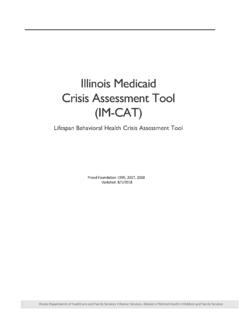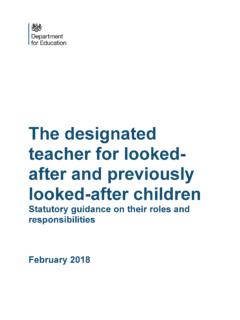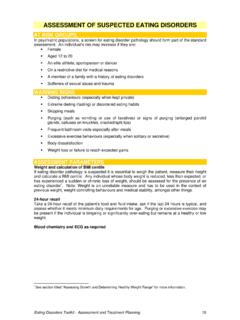Transcription of Situation Analysis - UNHCR
1 ARC (Action for the Rights of Children)_____ _____Situation Analysis 2/99 Page 1 ToolsSituation AnalysisContentsPageBriefing for FacilitatorsIntroduction .. 2 Guidance for Facilitators .. 5 Topic 1: Causes of Emergency Settlement .. 7 Topic 2: Contexts of Emergency 10 Topic 3: The Process of Situation Analysis .. 14 Topic 4: The Content of a Child-Centred Situation Analysis .. 18 Topic 5: An Introduction to Observation Skills .. 21 Topic 6: An Introduction to Interviewing Skills .. 23 Topic 7: Eliciting Socio-Cultural Information .. 25 Topic 8: An Introduction to Simple Survey and Participatory Assessment Techniques.
2 28 Topic 9: Ethical Analysis .. 33 Participant 36 Sample 40 Training 119 ResourcesReading List .. 127 Useful Addresses & 128 ARC (Action for the Rights of Children)_____ _____Situation Analysis 2/99 Page 2 Situation Analysis :IntroductionThe most important part of this module is the content. Before attempting any training usingthe materials in this module, read through the Key Concepts Paper, handouts, overheads andReading papers carefully. You need to understand the material fully in order to train others. Ifyou have not recently trained or worked in the area covered by this module, please reread itbefore starting to plan your TO THE MODULEThis module is designed to give a broad overview of the topic of Situation Analysis relatingto children, adolescents and families, and an introduction to the skills required.
3 The mainemphases on this Module are on how to enabling participants to examine particular situations,to consider what information is required and how to acquire it, and to analyse it in order tomake planning first part of this Module provides an introduction to the causes and contexts ofemergency settlement (Topics 1 and 2)1 and an overall discussion of some of the key issuesand the process of Situation Analysis (Topic 3). It also offers a broad introduction to some ofthe skills and techniques required. These are found in Topics 4 - 8, which elaborate uponsome selected aspects of the process of Situation Analysis .
4 Topic 9 offers a specific module onEthical Analysis which can be used in situations where participants need inputs to help themto deal with difficult ethical issues and includes a complex case study of the most useful and effective methods of learning about Situation Analysis , especiallyfor field-based workers, is to get course participants to work on their own current worksituation: for example, by giving participants a pre-course task which they work on during thecourse, or a mid-course task to bring back for the second part of a two-part course. In eitherof these cases, students might benefit from the provision of some simple guidelines, followedby a Situation Analysis task and then more detailed discussion in planning sessions on Situation Analysis , trainers and facilitators are advised to alsoconsider the component of Situation Analysis within each of the other modules.
5 For example,they might choose to use aspects of this module to facilitate a better understanding of the typeof Situation Analysis needed when considering the issue of separated or disabled module should be seen more as a tool than a subject in itself. There will also besignificant areas of overlap between this module and that on Community Mobilisation. 1 Topics 1 & 2 draw extensively on: Typology and Causes of Emergency Settlement. In: New Approaches to New Realities. Proceedings ofthe First International Emergency Settlement Conference.
6 University of Wisconsin, April 15 - 19 1996 ARC (Action for the Rights of Children)_____ _____Situation Analysis 2/99 Page 3 KEY CONCEPTS As the number of uprooted persons in the world increases, the size and frequency ofemergency operations have increased and are more complex. The crises are intertwined witha variety of political, military, economic, social and legal interests which involve complexhistorical origins and contemporary issues. The focus of this module is on issues to be considered in conducting a child-focused situationassessment. The first two topics introduce the general framework for Situation Analysis ,taking into account the factors outlined above.
7 An awareness of the full range of populations,2causes, situations and issues associated with emergency settlement is essential in order torespond to the challenges presented by the rapid and sometimes overlapping succession ofuprooted populations who are in need of protection and assistance. Situation Analysis is the process of assessing a complex Situation within its wider context,systematically gathering information, identifying the main problems and needs within arefugee population, identifying the principal resources contained within that population,and analysing the information gathered in order to facilitate the process of planning in asystematic, strategic, integrated and co-ordinated manner.
8 It differs from the narrower concept of needs assessment in that it has a broader scope inits focus on the wider context and in identifying refugee capacities and resources as wellas needs and problems. Situation Analysis requires a range of different focuses - from the Situation of individualchildren through to families, the refugee community, the whole refugee movement(possibly involving several countries) and the wider social and political context of thecountry of origin and host country. Hence it can be seen as an Analysis both from theperspective of the community and also in the wider context.
9 The communityperspective focuses mainly on information derived from the refugee community itself,while the Analysis from the wider perspective requires a more macro approach, drawing onwider sources of information and attempts to set the refugee community within a widerregional context. In practice, however, the two approaches are not wholly different;refugees themselves often have a clear understanding of the broader social and politicalcontext. This Module focuses mainly on the community perspective and concentratesspecifically on issues relating to children and module does not attempt an exhaustive exploration of Situation Analysis - rather thefollowing core concepts are examined:1.
10 A child-centred Situation Analysis requires a good understanding of how children sexperiences are likely to impact on their development, and how various aspects oflife in a refugee Situation will facilitate or impede development. 2 Characteristics of emergency populations are outlined in Handout SA (Action for the Rights of Children)_____ _____Situation Analysis 2/99 Page 42. An understanding of the socio-cultural background of the refugees, and of the hostsociety, is required. 3. Situation Analysis requires an appraisal of refugee capacities and resources as wellas problems and needs.















